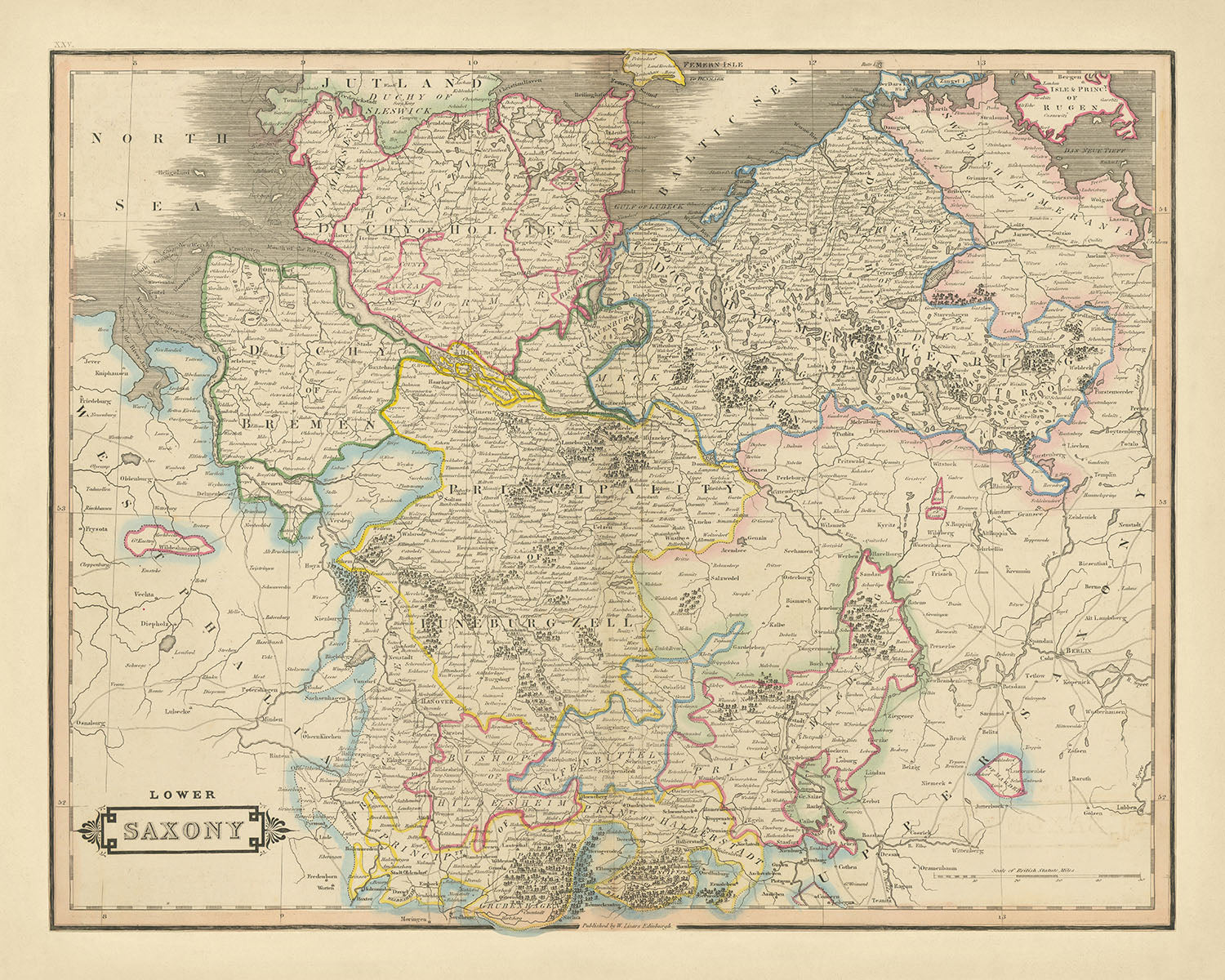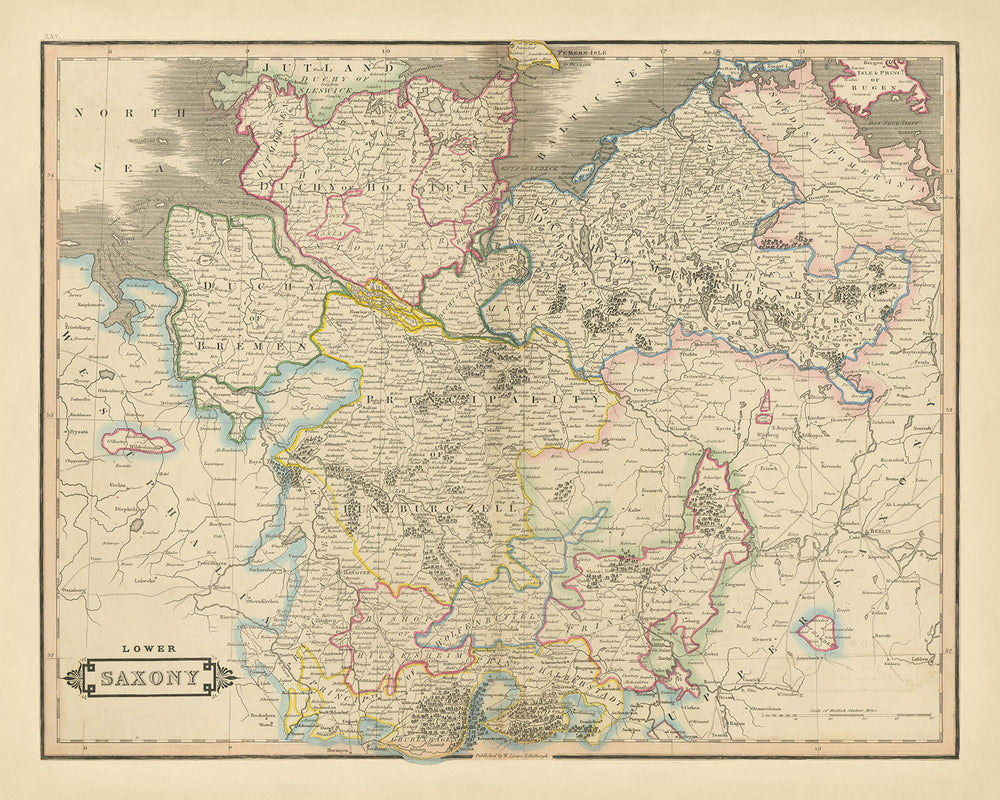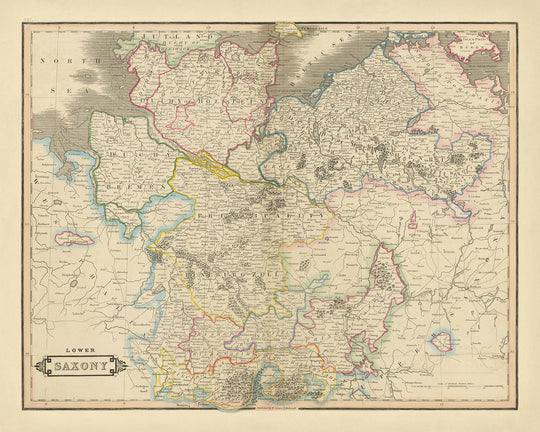- Handmade locally. No import duty or tax
- FREE Delivery by Christmas
- Love it or your money back (90 days)
- Questions? WhatsApp me any time
Own a piece of history
5,000+ 5 star reviews


"Lower Saxony," an exquisite cartographic masterpiece created by William Home Lizars in 1828, offers a captivating glimpse into the historical and geographical intricacies of early 19th-century Europe. Lizars, a renowned Scottish engraver and publisher, is celebrated for his meticulous and artistic approach to mapmaking. This map is a testament to his skill, featuring detailed illustrations of towns, roads, forests, and other geographical features. It provides a window into the post-Napoleonic era, a time of significant political and territorial reconfiguration following the Congress of Vienna in 1815.
The map's design is a marvel of early 19th-century cartographic techniques, with its intricate demarcation of duchies, principalities, and bishoprics. Notably, it includes regions such as the Duchy of Holstein, Duchy of Mecklenburg, and the Principality of Luneburgzell, each carefully outlined to reflect the political landscape of the time. The presence of Berlin, prominently positioned on the right side despite being outside the depicted region, underscores the city's burgeoning importance as a central node in Germanic territories. This inclusion hints at the sociopolitical significance of Berlin during this transformative period in European history.
Geographical features are rendered with exceptional detail, showcasing the natural beauty and diversity of the region. The map highlights major rivers such as the Elbe, Weser, and Ems, which have historically been vital for trade and transportation. The Harz Mountains and Harz Forest are also prominently featured, adding a layer of natural topography that enhances the map's aesthetic and informational value. These features not only provide a sense of place but also offer insights into the natural barriers and resources that shaped the development of the region.
The map is rich with historical context, capturing the flux and transformation of 19th-century Europe. The careful delineation of borders and regions offers scholars and historians a valuable resource for understanding the evolving nature of territorial boundaries during this period. The inclusion of major roads connecting towns and regions reflects the growing importance of infrastructure in facilitating trade and communication. This map stands as a geographical tool and an artifact bearing witness to the significant political and social changes of the time.
William Home Lizars' "Lower Saxony" is more than just a map; it is a piece of history, a work of art, and a testament to the intricate craftsmanship of early 19th-century cartography. Its detailed depiction of towns, forests, rivers, and political boundaries provides a comprehensive overview of the region's geography and history. For collectors and enthusiasts of historical maps, this piece offers a unique opportunity to own a snapshot of a pivotal moment in European history, rendered with the precision and artistry that only Lizars could achieve.
Cities and towns on this map
- Berlin (though outside Lower Saxony, it is included on the map)
- Hanover
- Brunswick
- Göttingen
- Celle
- Luneburg
- Stade
- Osnabrück
- Hildesheim
- Wolfenbüttel
- Hamelin
- Goslar
- Emden
- Leer
- Aurich
- Wilhelmshaven
- Oldenburg
- Bremen
- Hamburg (though outside Lower Saxony, it is included on the map)
- Lübeck (though outside Lower Saxony, it is included on the map)
Notable Features & Landmarks
- Rivers:
- Elbe River
- Weser River
- Ems River
- Forests:
- Harz Forest
- Bodies of Water:
- North Sea
- Mecklenburg Lake Plateau
- Mountain Ranges:
- Harz Mountains
- Historical regions:
- Duchy of Holstein
- Duchy of Mecklenburg
- Principality of Luneburgzell
- Principality of Halberstadt
- Roads:
- Major connecting routes between towns and regions
- Borders:
- Clearly marked boundaries of duchies, principalities, and bishoprics
Historical and design context
- Creation date: Circa 1828
- Mapmaker/Publisher: William Home Lizars, Edinburgh
- Interesting context about the mapmaker: William Home Lizars was a noted Scottish engraver and publisher known for his detailed and artistic cartographic works in the early 19th century.
- Topics and themes shown on the map:
- Political boundaries: The map delineates various duchies, principalities, and bishoprics, reflecting the political landscape of the time.
- Geographical features: It includes detailed illustrations of towns, roads, forests, and other geographical features.
- Historical context: The map provides insight into the post-Napoleonic reconfiguration of German territories following the Congress of Vienna in 1815.
- Design and style of the map:
- The map features intricate cartographic techniques typical of the early 19th century, with careful demarcation of regions and detailed illustrations.
- Historical significance:
- The map captures the evolving nature of territorial boundaries during the 1820s, a crucial period in European history.
- It stands as a valuable resource for understanding the political and territorial shifts in German states that contributed to the formation of the German Confederation and later the German Empire.
Please double check the images to make sure that a specific town or place is shown on this map. You can also get in touch and ask us to check the map for you.
This map looks great at every size, but I always recommend going for a larger size if you have space. That way you can easily make out all of the details.
This map looks amazing at sizes all the way up to 90in (230cm). If you are looking for a larger map, please get in touch.
The model in the listing images is holding the 16x20in (40x50cm) version of this map.
The fifth listing image shows an example of my map personalisation service.
If you’re looking for something slightly different, check out my collection of the best old maps to see if something else catches your eye.
Please contact me to check if a certain location, landmark or feature is shown on this map.
This would make a wonderful birthday, Christmas, Father's Day, work leaving, anniversary or housewarming gift for someone from the areas covered by this map.
This map is available as a giclée print on acid free archival matte paper, or you can buy it framed. The frame is a nice, simple black frame that suits most aesthetics. Please get in touch if you'd like a different frame colour or material. My frames are glazed with super-clear museum-grade acrylic (perspex/acrylite), which is significantly less reflective than glass, safer, and will always arrive in perfect condition.
This map is also available as a float framed canvas, sometimes known as a shadow gap framed canvas or canvas floater. The map is printed on artist's cotton canvas and then stretched over a handmade box frame. We then "float" the canvas inside a wooden frame, which is available in a range of colours (black, dark brown, oak, antique gold and white). This is a wonderful way to present a map without glazing in front. See some examples of float framed canvas maps and explore the differences between my different finishes.
For something truly unique, this map is also available in "Unique 3D", our trademarked process that dramatically transforms the map so that it has a wonderful sense of depth. We combine the original map with detailed topography and elevation data, so that mountains and the terrain really "pop". For more info and examples of 3D maps, check my Unique 3D page.
For most orders, delivery time is about 3 working days. Personalised and customised products take longer, as I have to do the personalisation and send it to you for approval, which usually takes 1 or 2 days.
Please note that very large framed orders usually take longer to make and deliver.
If you need your order to arrive by a certain date, please contact me before you order so that we can find the best way of making sure you get your order in time.
I print and frame maps and artwork in 23 countries around the world. This means your order will be made locally, which cuts down on delivery time and ensures that it won't be damaged during delivery. You'll never pay customs or import duty, and we'll put less CO2 into the air.
All of my maps and art prints are well packaged and sent in a rugged tube if unframed, or surrounded by foam if framed.
I try to send out all orders within 1 or 2 days of receiving your order, though some products (like face masks, mugs and tote bags) can take longer to make.
If you select Express Delivery at checkout your order we will prioritise your order and send it out by 1-day courier (Fedex, DHL, UPS, Parcelforce).
Next Day delivery is also available in some countries (US, UK, Singapore, UAE) but please try to order early in the day so that we can get it sent out on time.
My standard frame is a gallery style black ash hardwood frame. It is simple and quite modern looking. My standard frame is around 20mm (0.8in) wide.
I use super-clear acrylic (perspex/acrylite) for the frame glass. It's lighter and safer than glass - and it looks better, as the reflectivity is lower.
Six standard frame colours are available for free (black, dark brown, dark grey, oak, white and antique gold). Custom framing and mounting/matting is available if you're looking for something else.
Most maps, art and illustrations are also available as a framed canvas. We use matte (not shiny) cotton canvas, stretch it over a sustainably sourced box wood frame, and then 'float' the piece within a wood frame. The end result is quite beautiful, and there's no glazing to get in the way.
All frames are provided "ready to hang", with either a string or brackets on the back. Very large frames will have heavy duty hanging plates and/or a mounting baton. If you have any questions, please get in touch.
See some examples of my framed maps and framed canvas maps.
Alternatively, I can also supply old maps and artwork on canvas, foam board, cotton rag and other materials.
If you want to frame your map or artwork yourself, please read my size guide first.
My maps are extremely high quality reproductions of original maps.
I source original, rare maps from libraries, auction houses and private collections around the world, restore them at my London workshop, and then use specialist giclée inks and printers to create beautiful maps that look even better than the original.
My maps are printed on acid-free archival matte (not glossy) paper that feels very high quality and almost like card. In technical terms the paper weight/thickness is 10mil/200gsm. It's perfect for framing.
I print with Epson ultrachrome giclée UV fade resistant pigment inks - some of the best inks you can find.
I can also make maps on canvas, cotton rag and other exotic materials.
Learn more about The Unique Maps Co.
Map personalisation
If you're looking for the perfect anniversary or housewarming gift, I can personalise your map to make it truly unique. For example, I can add a short message, or highlight an important location, or add your family's coat of arms.
The options are almost infinite. Please see my map personalisation page for some wonderful examples of what's possible.
To order a personalised map, select "personalise your map" before adding it to your basket.
Get in touch if you're looking for more complex customisations and personalisations.
Map ageing
I have been asked hundreds of times over the years by customers if they could buy a map that looks even older.
Well, now you can, by selecting Aged before you add a map to your basket.
All the product photos you see on this page show the map in its Original form. This is what the map looks like today.
If you select Aged, I will age your map by hand, using a special and unique process developed through years of studying old maps, talking to researchers to understand the chemistry of aging paper, and of course... lots of practice!
If you're unsure, stick to the Original colour of the map. If you want something a bit darker and older looking, go for Aged.
If you are not happy with your order for any reason, contact me and I'll get it fixed ASAP, free of charge. Please see my returns and refund policy for more information.
I am very confident you will like your restored map or art print. I have been doing this since 1984. I'm a 5-star Etsy seller. I have sold tens of thousands of maps and art prints and have over 5,000 real 5-star reviews. My work has been featured in interior design magazines, on the BBC, and on the walls of dozens of 5-star hotels.
I use a unique process to restore maps and artwork that is massively time consuming and labour intensive. Hunting down the original maps and illustrations can take months. I use state of the art and eye-wateringly expensive technology to scan and restore them. As a result, I guarantee my maps and art prints are a cut above the rest. I stand by my products and will always make sure you're 100% happy with what you receive.
Almost all of my maps and art prints look amazing at large sizes (200cm, 6.5ft+) and I can frame and deliver them to you as well, via special oversized courier. Contact me to discuss your specific needs.
Or try searching for something!
















































